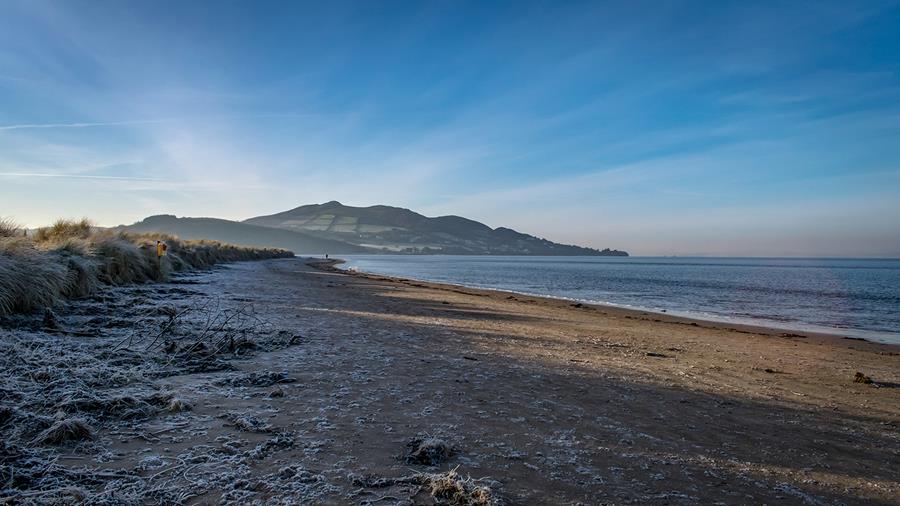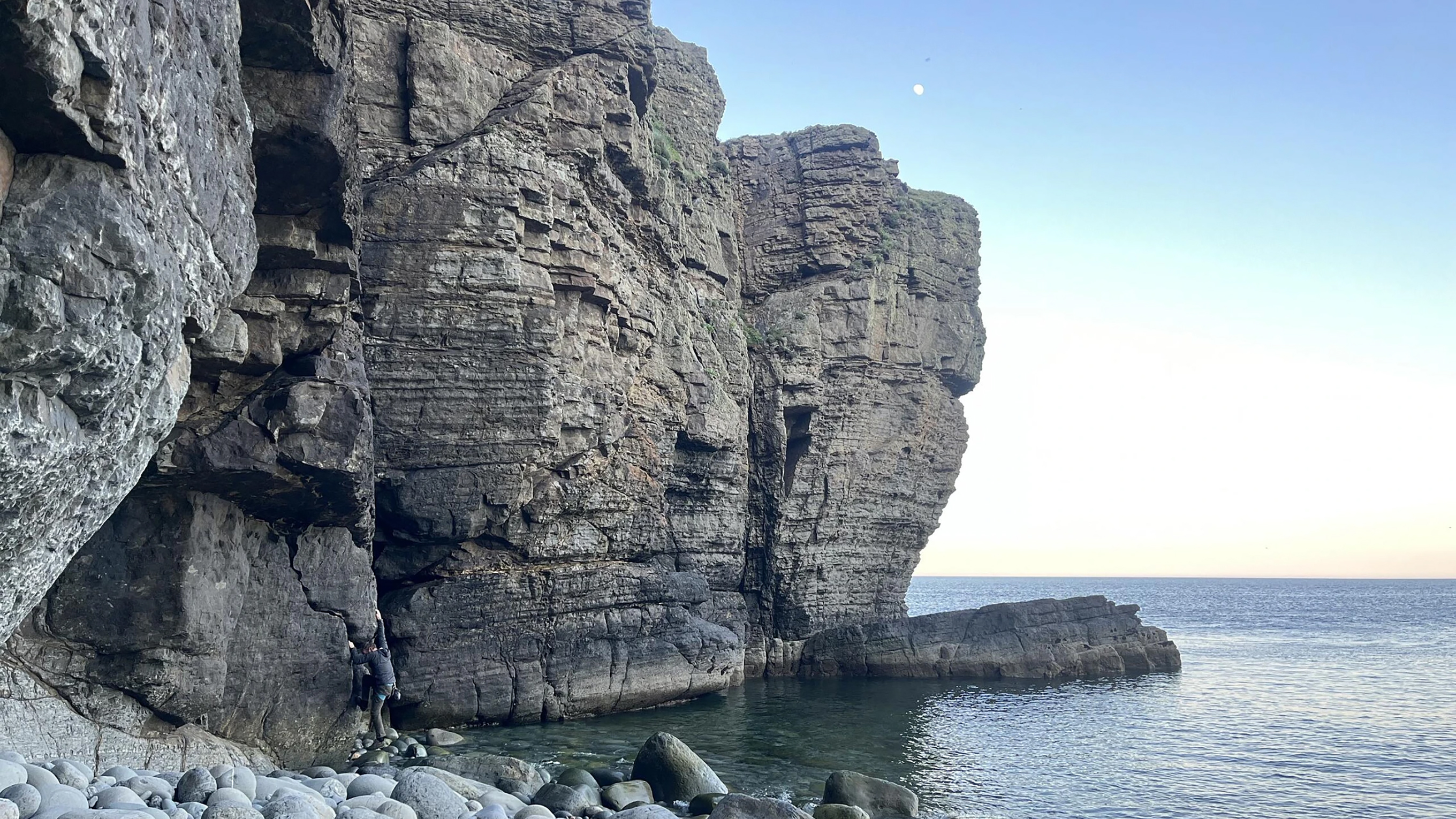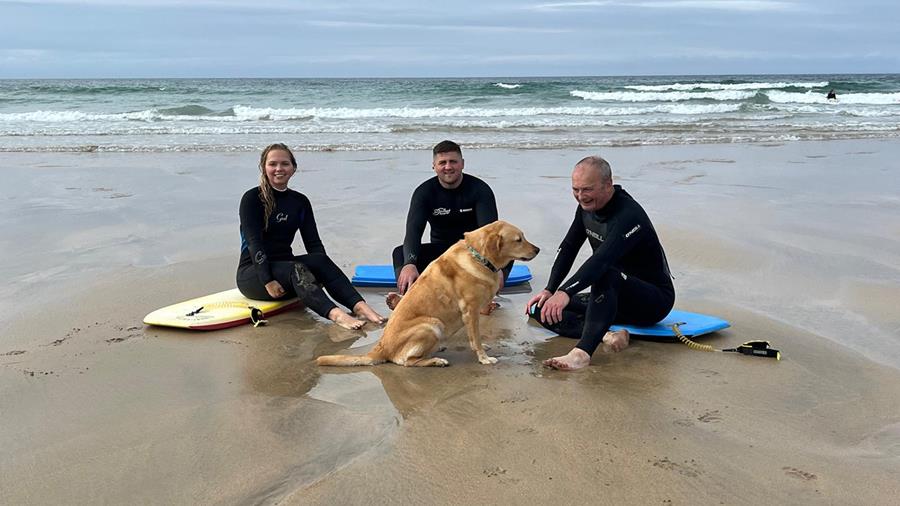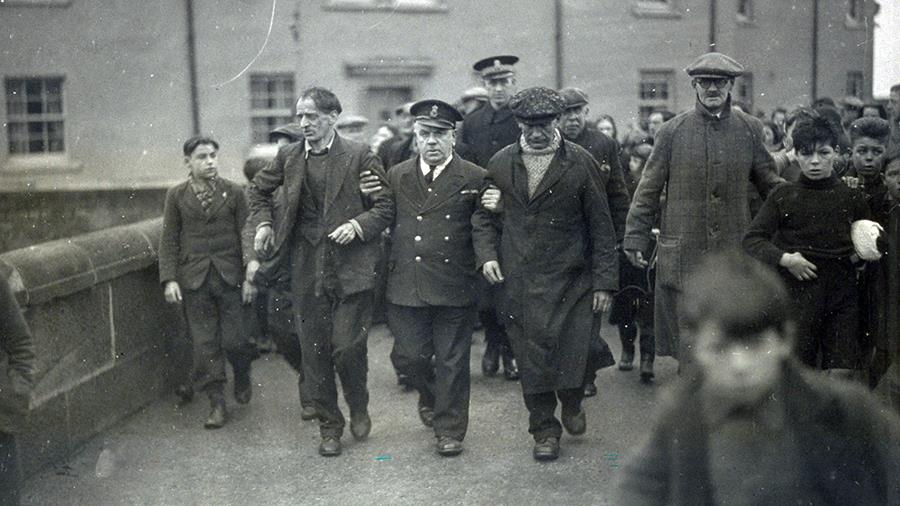

A fall at dusk
The light of a warm Sunday in May was fading when the frantic knocking came on the farmhouse door. A man had just witnessed his climbing partner fall more than 40 feet onto boulders under a sea cliff. Could anyone reach her and get her the medical help she urgently needed?
The injured climber, Vicki Hau, was well into her ascent of a rock-climb at the nearby headland of Trwyn Llech-y-Doll, when the rock she was climbing gave way. Her horrified climbing buddy Neil saw her fall onto the boulders below.
‘Something – if not everything – broke,’ recalls Vicki. ‘I went flying. I remember flipping upside down, then boom! I must have blacked-out for a few seconds because the next thing I can remember was Neil in front of me, my arms, the ropes, the boulders around me, covered in blood. I was trying to sit up and move my limbs. But I could feel my left lower leg was broken; any attempted movement resulted in nothing but intense pain.’
Neil covered her with his jacket and, realising there was no mobile phone signal, managed to run up the side of the cliff to dial 999, then rushed across a field to the nearby farm to inform them of the accident. Neil headed back to the overhanging clifftop, and shouted down to Vicki that he had called for help. Although still conscious, she was in shock and pain. ‘For a fleeting moment I started to get upset, thinking, “This can't be happening - the summer's only just begun,”’ says Vicki. But then I looked at my leg, the blood, my surroundings … and accepted my reality. At least I was alive.’
All she could do was wait and hope that some sort of help could reach her - by air, land or sea.
Over in Abersoch, a few miles to the north, RNLI volunteer Lifeboat Helm Andy Gunby was watching TV in his lounge. ‘It was a Sunday evening so I was thinking I’d better go to bed as I had to be up for work the next morning,’ says Andy, who works as an instructor in the fire service. But it would be hours before he would get any sleep – his pager sounded, summoning him and the rest of the Abersoch lifeboat volunteers to an immediate launch.
Arriving at the lifeboat station, Andy gathered what information was available and chose his crew accordingly. ‘I knew I might need to send crew ashore to treat severe injuries, so I asked a fellow helm, Phill Wood to come with us – he’s very experienced in casualty care and is also a community first responder outside the RNLI.’
Joined by Sion Flynn – a joiner by trade – and animal health worker Lee Oliver, Andy and Phil launched their rigid inflatable Atlantic 85 lifeboat to the scene. Coastguard teams had already arrived at the clifftop and shone their lights to show where Vicki lay – and to reveal how unstable the cliff face was. ‘It was quickly agreed that it was too dangerous for them to try and rescue Vicki via the cliff,’ recalls Andy.
The lifeboat crew now knew they would need to get someone ashore. ‘Andy asked me to go in first,’ explains Phill Wood, who prepared to enter the water as his fellow volunteers carefully took the lifeboat through a channel that took them towards the boulders at the foot of the cliff, lighting the way and keeping a close eye on the water depth.
When Andy had brought the Atlantic 85 as close as he could, Phill climbed overboard and waded through the sea, carrying a medical bag and handheld radio. ‘The casualty was surprisingly calm – she told me that she was an emergency room doctor,’ says Phill. ‘She had a dent in her helmet, a cut above her right eye, and her leg was clearly broken. She asked me to check her vertebrae – it didn’t feel like anything was out of place and she didn’t report pain there. But I was concerned about it. I used the radio to ask for Lee to come ashore too with a stretcher.’
Meanwhile, Helm Andy had requested a Coastguard helicopter, in the hope that Vicki could be airlifted to hospital from the scene. ‘Although our crew had a stretcher, I didn’t like the thought of them carrying a severely injured person through the water over submerged boulders.’
It wasn’t long before the helicopter arrived, to the relief of the lifeboat crew. But that relief was short-lived. ‘The thing is, you had an overhanging cliff with unstable rock, and us directly underneath it,’ explains Phill. ‘The helo crew were worried that their downdraft would dislodge rocks. So they decided it was too dangerous to send a winch down to us.’
It was time for an alternative extraction plan – and Andy had an idea. ‘I suggested that the helicopter land on a beach further down the coast, so that I could pick up their paramedic and bring them to Vicki.’
While Andy and Sion powered the lifeboat to meet the helicopter, the rest of the crew were doing their best for Vicki. ‘One of the great bits of kit we have in our inshore lifeboat medical bags these days is a painkiller called Penthrox,’ says Phil. ‘It comes in a whistle-like container that can be easily given to the casualty – and it takes up less room than a big cylinder of Entonox, which we wouldn’t have room for on an inshore lifeboat.’
With her adrenaline waning and pain increasing, Vicki used both Penthrox doses – enough to ease her discomfort for 40 minutes. But that time started to run out. ‘We really needed to get her more medical help – someone to splint her leg, give her more pain relief, and get her to hospital,’ says Phill. ‘It was dark and a lot cooler by now, and although we gave her blankets, she was only in her climbing gear on top of a cold rock.’
To the relief of the crew and climbers, the growl of the lifeboat engines returned – Andy was back with a Coastguard helicopter winch paramedic, who quickly headed ashore with Sion. Within minutes Vicki’s leg had been vacuum packed for protection and her back checked again, to make sure she could be moved.
‘The next bit was the toughest,’ says Phill. ‘We needed to carry Vicki on a stretcher, through the water, to the lifeboat. We were lucky that the sea wasn’t rough – but it was deep in places. You’re trying to keep the stretcher as stable as possible, despite trying to wade over a boulder field – shoulder-deep one minute, knee-deep the next.’
On the Atlantic 85, Andy decided to deflate a section of the lifeboat sponson to help get the stretcher aboard. ‘By the time they got to me they were swimming – it was going to be very difficult to smoothly lift Vicki over the side of a lifeboat from the sea. But they did it.’
The Coastguard paramedic continued to assess Vicki while Andy and the lifeboat crew headed along the coast to the nearby beach, and Vicki was taken into the helicopter. As it flew away, the RNLI volunteers took a moment to look back at what had just happened.
‘I felt lucky to have the experience I have and the experience around me in people like Phill,’ adds Andy. ‘I didn’t see a lot of what was going on because I was at the wheel, but the helm and command training we get from the RNLI played a part, because as well as operating the lifeboat I had a co-ordination role in the rescue too.’
‘Even though it was just four of us at times, we felt hugely supported, because we had all the right kit.’ adds Phill. ‘Kit like the Penthrox – we couldn’t have moved Vicki without pain relief. Plus the blankets to keep her warm, the PPE to protect us, and the radios to stay in touch. And we had the training too. It gives you confidence when you use the casualty care training and can see that it works. Often we hand over a casualty to an ambulance and we never hear anything afterwards. But Vicki came back to the station to thank us. And that’s when we found out the extent of her injuries.’
Initially Vicki, a doctor herself, had been taken to Bangor hospital’s accident and emergency department. But after a scan showed serious back injuries, she was transferred to Stoke-on-Trent’s spinal unit. ‘It transpired I had sustained a neck fracture, multiple thoracic spinal fractures needing surgery, plus a multi-fragmented left tibial fracture which needed a nail down from my knee to my ankle.’
‘I've been told many times how lucky I am to have got out of there in one piece, with no lasting brain or spinal injuries,’ adds Vicki, who needed a neck brace, spinal and leg surgery – but is now completely mobile again.
What would Vicki say to the RNLI volunteers who rescued her? ‘Thank you for everything you did that night, you saved my life. All with great skill and humour I won’t forget! The hard work, time and dedication RNLI volunteers put in is extraordinary and I will forever be indebted to the organisation.’
Categories
You may also enjoy the following







